What'sNEW Archives, March-April 2000
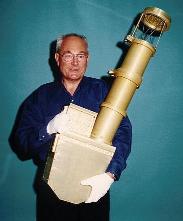
Max Planck scientist Jochen Kissel holds CIDA, the Comet and Interstellar Dust Analyzer |
April 27: Most interstellar particles captured by Stardust are complex organic compounds, and not the expected minerals. This is the conclusion of the team from Max-Planck Institute, Garching, that manages the mass-spectrometer, CIDA, on NASA's Stardust spacecraft. "The first in-situ chemical analysis of interstellar dust particles produces a puzzling result: These cosmic particles consist mostly of 3-dimensionally cross-linked organic macro-molecules, so-called polymeric-heterocyclic-aromates. They rather resemble tar-like substances than minerals."
 So far, 5 interstellar dust particles have been collected and analysed. "The instrument had been pointed into the direction of the interstellar dust, so that it would not measure the more frequent interplanetary dust particles, which are parts of our solar system.... At an impact speed of about 30 kilometers/second (18 miles/second) these interstellar dust particles are vaporized immediately and broken up into molecular fragments." So far, 5 interstellar dust particles have been collected and analysed. "The instrument had been pointed into the direction of the interstellar dust, so that it would not measure the more frequent interplanetary dust particles, which are parts of our solar system.... At an impact speed of about 30 kilometers/second (18 miles/second) these interstellar dust particles are vaporized immediately and broken up into molecular fragments."
 "It is the size of these molecular fragments with nuclear masses of up to 2000... which surprised us as much as the seemingly absence of any mineral constituents.... Only organic molecules can reach those sizes.... The details of the mass spectra measured with CIDA show that the molecules of the interstellar dust must have about 10% of nitrogen and/or oxygen in addition to hydrogen and carbon. This means that these cannot be pure PAHs, which are planar, but... extend into all three spacial directions." "It is the size of these molecular fragments with nuclear masses of up to 2000... which surprised us as much as the seemingly absence of any mineral constituents.... Only organic molecules can reach those sizes.... The details of the mass spectra measured with CIDA show that the molecules of the interstellar dust must have about 10% of nitrogen and/or oxygen in addition to hydrogen and carbon. This means that these cannot be pure PAHs, which are planar, but... extend into all three spacial directions."
 We are surprised and delighted to have such an important result from this mission, this early. [Thanks, Bruce Moomaw, Larry Klaes and Ron Baalke.] We are surprised and delighted to have such an important result from this mission, this early. [Thanks, Bruce Moomaw, Larry Klaes and Ron Baalke.]
 First Direct Chemical Analysis of Interstellar Dust, by Franz R. Krueger and Jochen Kissel, p 326-329 v 39, Sterne und Weltraum, May 2000. First Direct Chemical Analysis of Interstellar Dust, by Franz R. Krueger and Jochen Kissel, p 326-329 v 39, Sterne und Weltraum, May 2000.
 Cometary and Interstellar Dust Analyzer for comet Wild 2, by Jochen Kissel et al., doi:10.1029/2003JE002091, J. Geophys. Res., 30 Oct 2003. Cometary and Interstellar Dust Analyzer for comet Wild 2, by Jochen Kissel et al., doi:10.1029/2003JE002091, J. Geophys. Res., 30 Oct 2003.
 Tarlike Macro-Molecules Detected In Stardust, Max-Planck-Institut fur extraterrestrische Physik (+SpaceflightNow), 26 April 2000. Tarlike Macro-Molecules Detected In Stardust, Max-Planck-Institut fur extraterrestrische Physik (+SpaceflightNow), 26 April 2000.
 Stardust Detects Organic Molecules, SpaceDaily, 27 April 2000. Stardust Detects Organic Molecules, SpaceDaily, 27 April 2000.
 The Physical and Chemical Properties of Interstellar Dust and Dust in Comets: Possible Seeds for Life on Earth [CA reprint] by Franz R. Krueger and Jochen Kissel, May 2000. The Physical and Chemical Properties of Interstellar Dust and Dust in Comets: Possible Seeds for Life on Earth [CA reprint] by Franz R. Krueger and Jochen Kissel, May 2000.
 Analysis of Interstellar Dust is a related CA webpage. Analysis of Interstellar Dust is a related CA webpage.
 Can the Theory Be Tested? is a related CA webpage. Can the Theory Be Tested? is a related CA webpage.
 Cross-Linked Hetero Aromatic Polymers in Interstellar Dust by N.C. Wickramasinghe, D.T. Wickramasinghe and F. Hoyle [CA preprint]. Cross-Linked Hetero Aromatic Polymers in Interstellar Dust by N.C. Wickramasinghe, D.T. Wickramasinghe and F. Hoyle [CA preprint].
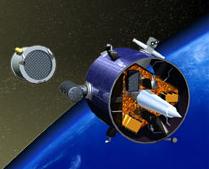 April 25:
April 25: The 4th International Conference on Low-Cost Planetary Missions will be held at The Johns Hopkins University Applied Physics Laboratory, Laurel, Maryland, 2-5 May 2000. [Thanks Bruce Moomaw and Larry Klaes.]
 International Conference to Focus on Status, Future of Low-Cost Planetary Missions, by Mike Buckley, JHU Applied Physics Laboratory, 20 April 2000. International Conference to Focus on Status, Future of Low-Cost Planetary Missions, by Mike Buckley, JHU Applied Physics Laboratory, 20 April 2000.
 Conference Website with a link to abstracts in "pdf" format. Conference Website with a link to abstracts in "pdf" format.
 Can the Theory Be Tested? is a related CA webpage. Can the Theory Be Tested? is a related CA webpage.
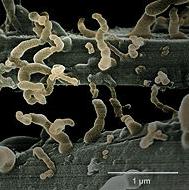 April 21: Nanobacteria continue to surprise microbiologists. A team at the University of Queensland (UQ) in St. Lucia, Australia cultured specimens from several kilometers under the ocean floor, where temperatures of 170ºC and pressures of 2,000 atmospheres are reached. "It appears that the nanobes were not actively growing in the rock from which they were retrieved, but thrive when exposed to aerobic conditions." The organisms withstand "repeated exposure to vacuum, bombardment by the electron beam, and X-ray radiation—and continue to grow," said UQ team member Philippa Uwins. "They resemble actinomycetes and fungi except for their remarkably smaller size—namely, filaments of variable lengths with diameters of 20-128 nm." Many bacteriologists remain sceptical.
April 21: Nanobacteria continue to surprise microbiologists. A team at the University of Queensland (UQ) in St. Lucia, Australia cultured specimens from several kilometers under the ocean floor, where temperatures of 170ºC and pressures of 2,000 atmospheres are reached. "It appears that the nanobes were not actively growing in the rock from which they were retrieved, but thrive when exposed to aerobic conditions." The organisms withstand "repeated exposure to vacuum, bombardment by the electron beam, and X-ray radiation—and continue to grow," said UQ team member Philippa Uwins. "They resemble actinomycetes and fungi except for their remarkably smaller size—namely, filaments of variable lengths with diameters of 20-128 nm." Many bacteriologists remain sceptical.
 Size Matters: Another Peek at the Ongoing Nanobe Debate, by Jeffrey L. Fox, ASM News, 10 April 2000. Size Matters: Another Peek at the Ongoing Nanobe Debate, by Jeffrey L. Fox, ASM News, 10 April 2000.
 Life on Mars! has more about nanobacteria, aka nanobes, with updates. Life on Mars! has more about nanobacteria, aka nanobes, with updates.
 Fossilized Life Forms in the Murchison Meteorite is a related CA webpage. Fossilized Life Forms in the Murchison Meteorite is a related CA webpage.
 April 14, 2000:
April 14, 2000: The microbial biosphere as a "World Wide Web" — That's how Nobel laureate Joshua Lederberg sees it, "with DNA serving as the packets of data going every which way." The rate of evolution can be so rapid that, as he comments, "A year in the life of bacteria would easily match the span of mammalian evolution!" Lederberg is not considering closed bacterial systems, but his remark renews our puzzlement — if Darwinian evolution is capable of composing new genes for new functions, shouldn't it have done so in the closed-system bacterial experiments that have already run for ten years now?
Lederberg goes on to mention, "Hundreds of segments of human DNA originated from historical encounters with retroviruses whose genetic information became integrated into our own genomes." This would exemplify the way life can evolve by acquiring new genetic programming in an open system.
 Joshua Lederberg, "The Microbial World Wide Web", p 291 v 288 Science, 14 April 2000 [link]. Joshua Lederberg, "The Microbial World Wide Web", p 291 v 288 Science, 14 April 2000 [link].
 In Real or Artificial Life... has more about the closed-system bacterial experiments, with updates. In Real or Artificial Life... has more about the closed-system bacterial experiments, with updates.
 Viruses... is the related CA webpage. [Next-What'sNEW about HGT-Prev] Viruses... is the related CA webpage. [Next-What'sNEW about HGT-Prev]
 10 Mar 2021: local hub for HGT among bacteria, with updated links. 10 Mar 2021: local hub for HGT among bacteria, with updated links.
April 12: Conference Reports — Reports on NASA's First Astrobiology Conference at Ames Research Center, April 3-5, and the 31st Lunar and Planetary Science Conference in Houston, March 13-17, are available.
 New field, 'astrobiology,' draws cadre of researchers, CNN.com, 13 April 2000. New field, 'astrobiology,' draws cadre of researchers, CNN.com, 13 April 2000.
 A Surveyor's Chronicles (part 1 of 4 from Houston), by Bruce Moomaw, SpaceDaily, 11 April 2000. A Surveyor's Chronicles (part 1 of 4 from Houston), by Bruce Moomaw, SpaceDaily, 11 April 2000.
 Increasing Evidence That Europa Lives (part 1 of 5 from Ames), by Bruce Moomaw, SpaceDaily, 11 April 2000. Increasing Evidence That Europa Lives (part 1 of 5 from Ames), by Bruce Moomaw, SpaceDaily, 11 April 2000.
 Astrobiology: Flights of fancy (with links to later stories), by Alan Boyle, MSNBC, 30 March 2000. Astrobiology: Flights of fancy (with links to later stories), by Alan Boyle, MSNBC, 30 March 2000.
 Henry Bortman and Philip Ball, "Storming the Tower of Babel," p 700 v 404 Nature, 13 April 1999. Henry Bortman and Philip Ball, "Storming the Tower of Babel," p 700 v 404 Nature, 13 April 1999.
 Robert Irion, "The Science of Astrobiology Takes Shape" [summary], p 603-605 v 288 Science, 28 April 1999. Robert Irion, "The Science of Astrobiology Takes Shape" [summary], p 603-605 v 288 Science, 28 April 1999.
April 12: More on Contamination — Now that the return of soil samples from Mars has been delayed, there's more time to consider cross-contamination issues. We suspect that Mars-to-Earth transfer of material that could bring live germs has happened repeatedly and we do not want Mars exploration to be unnecessarily impeded. But it's good to listen to the conservatives. [Thanks, Barry DiGregorio.]
 Sample Return Missions Scare Some Researchers, space.com, 9 April 2000. Sample Return Missions Scare Some Researchers, space.com, 9 April 2000.
 Could bugs from Mars hitch a ride to Earth?, by Faye Flam, The Inquirer (Philadelphia), 27 March 2000. Could bugs from Mars hitch a ride to Earth?, by Faye Flam, The Inquirer (Philadelphia), 27 March 2000.
 Mars Sample Mission: All or Nothing Proposition, Scientist Says, by Andrew Bridges, Space.com, 10 April 2000. Mars Sample Mission: All or Nothing Proposition, Scientist Says, by Andrew Bridges, Space.com, 10 April 2000.
 April 9, 2000:
April 9, 2000: A DNA virus... could have been the ancestor of the eukaryotic replication system. This profound conclusion comes from molecular biologist Luis P. Villarreal in a 30-page review article published as Chapter 15 in a new medical book, Origin and Evolution of Viruses. Early in the article Villarreal states unequivocally, "In bacteria and their DNA viruses, the major process of genetic adaptation and evolution involves the horizontal transfer of genetic elements... [by] either... virus infection or... various parasitic genetic elements that use a virus-like replication/mobilization process" (emphasis added). Also, sequences show that the DNA polymerase gene in T4 (a virus that infects bacteria) is related to DNA polymerase genes in eukaryotes and their viruses. Ultimately, concerning eukaryotes, he asks, "Could virus-mediated large-scale gene transmission allow the evolution of complex characteristics not attainable by point changes?" Cosmic Ancestry also makes this suggestion. In our experience, the most straightforward interpretation of data pertaining to evolution often comes from the medical field.
 Luis P. Villarreal, "DNA Virus Contribution to Host Evolution," p 391-420, Origin and Evolution of Viruses, Esteban Domingo, Robert Webster and John Holland, eds., Academic Press, 1999 [2nd Edition, Elsevier, 2008]. Luis P. Villarreal, "DNA Virus Contribution to Host Evolution," p 391-420, Origin and Evolution of Viruses, Esteban Domingo, Robert Webster and John Holland, eds., Academic Press, 1999 [2nd Edition, Elsevier, 2008].
 Dr. Luis P. Villarreal, Homepage at the University of California, Irvine. Dr. Luis P. Villarreal, Homepage at the University of California, Irvine.
 28 Feb 2006 28 Feb 2006  24 Mar 2006 24 Mar 2006  19 Nov 2014 19 Nov 2014  22 Jun 2015: more references to Villarreal. 22 Jun 2015: more references to Villarreal.
 Viruses... is the related CA webpage. [Next-What'sNEW about HGT-Prev] Viruses... is the related CA webpage. [Next-What'sNEW about HGT-Prev]
April 6: Astrobiology Conference — Flying over drying Mono Lake, the varied reds of Bryce Canyon, and the deep relief of the Lake Powell terrain, I can easily imagine that this is Mars. Detailed images of the red planet were everywhere at the Astrobiology Conference. One of the aims of the meeting was to contribute to the establishment of astrobiology as a legitimate discipline, and there it succeeded. Life may exist on other planets, and Earth science is relevant on Mars, Europa and elsewhere. Science can begin to suggest where life-as-we-know-it is possible in other solar systems, and even other galaxies. But of course the conference cannot be easily encapsulated. Selected points of interest to us were —
- Tiny drops of liquid-phase water could fleetingly exist on the surface of Mars today (R.M. Haberle et al.)
- Isotopic analysis of Australian rocks suggests that liquid oceans left sediment beds on Earth 4.28 billion years ago (S.J. Mojzsis et al.)
- After the Viking missions, "NASA never said there was no life on Mars" (G. Soffen, personal conversation).
- Horizontal gene transfer may be "the main determinant of taxonomic units in prokaryotes" (J.P. Gogarten et al.)
- "Rampant horizontal gene transfer has occurred for... operational genes" (J. Lake et al.)
- Genes for insulin and brain peptides are found in primitive microbes that have no need for them (Simon Conway Morris in a talk about the ubiquity of convergence in evolution).
- The number of "gene expression events" may be the best measure of complexity (J. W. Valentine).
- The zone within a galaxy that has enough heavy elements, water, and not too many impact events to allow for life may be relatively narrow (G. Gonzales and P. Ward).
- "The possibility that we descend from inadvertant spacefarers.... has gone from speculation to truism in less than five years" (K. Zahnle).
- Undisturbed magnetites in ALH 84001 could never have been heated above 40 degrees C, so bacteria from Mars would not have been heat-sterilized when the meteorite travelled to Earth (B.P. Weiss et al.)
- For planets with an atmosphere as dense as Earth's, atmospheric heating of meteorites is much worse upon leaving than entering (C. Mileikowsky et al.)
- Lots of new instruments and methods for seeking life on Mars were proposed.
- One poster suggested that sustained macroevolutionary progress including the origin of life "in the first place," needs to be demonstrated in closed-system tests before science can be sure it is possible (B. Klyce). A standard interpretation of the big bang theory would make this confirmation unnecessary, and an unlikely but powerful coalition of Darwinists and creationists endorses this interpretation. The poster attracted only modest traffic.
April 3: The First Astrobiology Conference at NASA's Ames Research Center began with "standing rooom only" in the lecture hall. The theme of the morning session was water, and opening speaker Phillip Ball concludes that it is necessary for life. Richard Greenberg explained that the ice on Europa must be thin, and Robert Pappalardo said it's more lilkely thick — both expect to find life there. Then Jody Deming told how diatoms thrive in brine pores in sea ice at minus 15 degrees centigrade. Paul Hoffman was especially entertaining and edifying on the new "snowball earth" theory — runaway freezing followed by very fast thawing at least twice just before the Cambrian explosion. Not counting the introductory ones, there were fifteen science lectures. Finally came the poster session with posters arranged into 31 categories. Among the ones near mine were those of Robert Folk (nannobacteria — as he spells it) and Everett Gibson et al. (Mars geology). There are no posters or scheduled talks on computer models that even claim to mimic macroevolutionary progress, but simple panspermia is well represented. The conference runs until Wednesday evening, 5 April.
 In a lunchtime visit Frances Westall confirmed that contamination is a powerful obstacle for proponents of extraterrestrial fossils in meteorites. But word is that the biogenic nature of the magnetite in Mars meteorite ALH 84001 may be irrefutable. Also, both US and Canadian agencies are testing samples of January's Yukon meteorite, a carbonaceous chondrite, parts of which can hardly be contaminated. The fragments gathered first were below the melting point of water soon after they landed. In a lunchtime visit Frances Westall confirmed that contamination is a powerful obstacle for proponents of extraterrestrial fossils in meteorites. But word is that the biogenic nature of the magnetite in Mars meteorite ALH 84001 may be irrefutable. Also, both US and Canadian agencies are testing samples of January's Yukon meteorite, a carbonaceous chondrite, parts of which can hardly be contaminated. The fragments gathered first were below the melting point of water soon after they landed.
 Astrobiology Field Draws Researchers, by Martha Mendoza, space.com, 5 April 2000. Astrobiology Field Draws Researchers, by Martha Mendoza, space.com, 5 April 2000.
 Is Sustained Macroevolutionary Progress Posssible? is the abstract of Brig Klyce's poster. Is Sustained Macroevolutionary Progress Posssible? is the abstract of Brig Klyce's poster.
April 1: NASA's Astrobiology Science Conference, 3-5 April. More than 300 posters and 49 oral presentations are scheduled at NASA's Ames Research Center, Mountain View, California. I will present one of the posters.
 First Astrobiology Science Conference, Astrobiology Web, has links to the schedule and abstracts. First Astrobiology Science Conference, Astrobiology Web, has links to the schedule and abstracts.
 First Astrobiology Science Conference, official conference homepage at NASA. First Astrobiology Science Conference, official conference homepage at NASA.
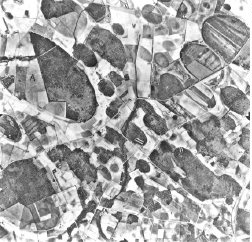 March 29:
March 29: Shallow craters called "Carolina Bays" cover the coastal plain of the southeastern United States. The craters are elliptical, with their long axes nearly parallel. They range from 200 feet to 7 miles in longest diameter. They were most likely created by fragments of a comet that slowed and disintegrated after striking the atmosphere from the northwest. At ground level the bays resemble ordinary fields, marshes, or ponds. Many have been drained and cultivated. But seen from above they still are quite noticeable. The number of them is estimated from 500,000 to 2,500,000. Their age is recent — probably less that 15,000 years. An intriguing finding is that sediments from some of them contain bacterial species different from any known on Earth. ...None of the clones exhibited an exact match to any of the 16S rDNA sequences deposited in numerous databases. "This suggests that most of the bacteria in Rainbow Bay are novel species," said Lawrence Shimkets, a University of Georgia biologist, in 1997.
 "Previously Unknown Bacteria Discovered By University Of Georgia Researchers In Features Called Carolina Bays," University of Georgia Press Release, 9 April 1997. "Previously Unknown Bacteria Discovered By University Of Georgia Researchers In Features Called Carolina Bays," University of Georgia Press Release, 9 April 1997.
 Henry Savage, Jr. The Mysterious Carolina Bays. University of South Carolina Press. 1982. Henry Savage, Jr. The Mysterious Carolina Bays. University of South Carolina Press. 1982.
 The Riddle of the Carolina Bays, Smithsonian Magazine, September 1997. The Riddle of the Carolina Bays, Smithsonian Magazine, September 1997.
 A Re-evaluation of the Extraterrestrial Origin of the Carolina Bays by J. Ronald Eyton and Judith I. Parkhurst: n9, Geography Graduate Student Association, University of Illinois at Urbana Champaign, April 1975. A Re-evaluation of the Extraterrestrial Origin of the Carolina Bays by J. Ronald Eyton and Judith I. Parkhurst: n9, Geography Graduate Student Association, University of Illinois at Urbana Champaign, April 1975.
 More Carolina Bay Information from the University of Georgia. More Carolina Bay Information from the University of Georgia.
 The Carolina Bays by George A. Howard. The Carolina Bays by George A. Howard.
 Comets: The Delivery System is the related CA webpage. Comets: The Delivery System is the related CA webpage.
 March 28:
March 28: NASA's report on the recent Mars mission failures is out. The Polar Lander probably crashed because it received a premature signal to shut off its descent engine. Shutoff was supposed to be prompted when the lander's legs flexed as it touched down; but the shutoff could have been prompted prematurely if the legs bounced when the parachute opened. The problem was not detected before launch, because the parachute-deployment and touchdown sequences were tested only separately.
 Mars Program Assessment Report Outlines Route to Success, NASA News Release 00-46, by Peggy Wilhide, 28 March 2000. Mars Program Assessment Report Outlines Route to Success, NASA News Release 00-46, by Peggy Wilhide, 28 March 2000.
 NASA Begins Clean Up of 'Mars Mess', by Leonard David, Space.com, 27 March 2000. NASA Begins Clean Up of 'Mars Mess', by Leonard David, Space.com, 27 March 2000.
 Warren E. Leary, "Poor Management by NASA Is Blamed for Mars Failure" [text], The New York Times, 29 March 2000.
If there's life on Mars, do we investigate, or stay clear? Warren E. Leary, "Poor Management by NASA Is Blamed for Mars Failure" [text], The New York Times, 29 March 2000.
If there's life on Mars, do we investigate, or stay clear?
 Hands Off the Planet? How Finding Life On Mars Could Stop Exploration, by Leonard David, space.com, 28 March 2000. Hands Off the Planet? How Finding Life On Mars Could Stop Exploration, by Leonard David, space.com, 28 March 2000.
 Life on Mars! is the related CA webpage. Life on Mars! is the related CA webpage.
 March 23:
March 23: Extraterrestrial gases trapped in molecular cages are found around the world in a sediment layer that marks the extinction event 65-million years ago, and in the Murchison and Allende carbonaceous meteorites. Among the gases are isotopes of helium that cannot be earthly. The cages made of carbon molecules are nicknamed "buckyballs," short for Buckminster Fullerine, after the inventor of geodesic domes. [Thanks, Randy Bowen.]
 Researchers Discover Extraterrestrial Gases in Buckyballs, NASA News Release 00-20AR, by John Bluck, 20 March 2000. Researchers Discover Extraterrestrial Gases in Buckyballs, NASA News Release 00-20AR, by John Bluck, 20 March 2000.
 Luann Becker, Robert J. Poreda and Ted E. Bunch. "Fullerenes: An extraterrestrial carbon carrier phase for noble gases" [abstract], Proc. Natl. Acad. Sci. USA, online preprint posted 21 March 2000. Luann Becker, Robert J. Poreda and Ted E. Bunch. "Fullerenes: An extraterrestrial carbon carrier phase for noble gases" [abstract], Proc. Natl. Acad. Sci. USA, online preprint posted 21 March 2000.
March 22: Life on Europa gets a favorable assessment from University of Arizona astronomer Richard Greenberg. He will present the case at the First Annual Astrobiology Conference, April 3-5, at NASA's Ames Research Center, California.
 Scientist Puts Short Odds On Europan Life, by Lori Stiles, SpaceDaily, 21 March 2000. Scientist Puts Short Odds On Europan Life, by Lori Stiles, SpaceDaily, 21 March 2000.
 Astrobiology Science Conference, NASA, Ames. Astrobiology Science Conference, NASA, Ames.
 Life on Europa... has links to WhatsNEW on Jupiter's and other moons. Life on Europa... has links to WhatsNEW on Jupiter's and other moons.
March 19: The Mars sample return mission is postponed. No samples will be returned before 2010. More generally, "The search for life on the Red Planet will have to slow down until people on Earth have worked out how to land on Mars without crashing," said Dr. Carl Pilcher, head of NASA's planetary exploration program, at the annual Lunar and Planetary Science Conference in Houston, Texas, March 13-17. After two recent failed Mars missions, we agree that the slowdown is warranted. We welcome, by the way, Pilcher's characterization of the Mars program as a search for life — that seems new. [Thanks, Barry DiGregorio.]
 NASA pulls back from Mars, by David Whitehouse, BBC News Online, 17 March 2000. NASA pulls back from Mars, by David Whitehouse, BBC News Online, 17 March 2000.
 Andrew Lawler, "Reports Will Urge Overhaul and Delays to NASA's Mars Missions" [abstract], p 1722-1723 v 287 Science, 10 March 2000. Andrew Lawler, "Reports Will Urge Overhaul and Delays to NASA's Mars Missions" [abstract], p 1722-1723 v 287 Science, 10 March 2000.
 Life on Mars! is the related CA webpage. Life on Mars! is the related CA webpage.
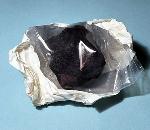
Yukon meteorite in plastic |
March 18: Pristine samples of January's Yukon meteorite, a carbonaceous chondrite, have been collected. A Yukon resident quickly gathered about two pounds of fragments while they were still frozen, and he kept them isolated and frozen. Other carbonaceous meteorites (chondrites and non-chondrites) have been found to contain fossilized bacteria, but earthly contamination has not been definitively ruled out for them. The collection method used for the Yukon samples should eliminate the possibility of contamination. We eagerly await the analysis of this meteorite. [Thanks, Francisco Carrapico.]
 Yukon Meteorite May Provide "New Window into The Universe", NASA News Release H00-41, 16 March 2000. Yukon Meteorite May Provide "New Window into The Universe", NASA News Release H00-41, 16 March 2000.
 Pristine Yukon Meteorite A Rare Find, by Glen Golightly, Space.com, 16 March 2000. Pristine Yukon Meteorite A Rare Find, by Glen Golightly, Space.com, 16 March 2000.
 Yukon Meteorite Recovered, by Tony Phillips, Space Science News, 16 March 2000. Yukon Meteorite Recovered, by Tony Phillips, Space Science News, 16 March 2000.
 Rare meteorite promises glimpse into dawn of creation, CNN.com, 17 March 2000. Rare meteorite promises glimpse into dawn of creation, CNN.com, 17 March 2000.
 Comets: The Delivery System is a related CA webpage. Comets: The Delivery System is a related CA webpage.
March 18: DNA can be installed into plant cells ten times more easily in space than on Earth. This indication comes from soybean experiments conducted by John Glenn in 1998. The analysis was published by the American Chemical Society in January, 2000. A team led by Purdue University agronomist Richard Vierling plans more experiments with soybeans on the next space shuttle, scheduled for launch April 13.
 Purdue researcher finds space fertile arena for gene transfers, by Beth Forbes, Purdue University, Apr 2000. Purdue researcher finds space fertile arena for gene transfers, by Beth Forbes, Purdue University, Apr 2000.
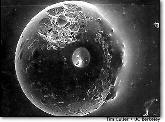 March 18:
March 18: "A striking increase in the cratering rate over the last 400 million years" is indicated by research on tiny glass beads gathered with regolith from the moon by Apollo 14 astronauts. The research team from the University of California, Berkeley, even comments that the increase coincides roughly with the Cambrian explosion. This suggestion has been controversial. [Thanks, Kevin Keogh.]
 "Life From Extraterrestrial Seeding?: Dating of Moon Impacts Suggests Link to Flowering of Complex Species" [text], p A06 Washington Post, 10 March 2000. "Life From Extraterrestrial Seeding?: Dating of Moon Impacts Suggests Link to Flowering of Complex Species" [text], p A06 Washington Post, 10 March 2000.
 John Noble Wilford, "Analysis of Lunar Debris Offers Clues to Life on Earth" [text], The New York Times, 14 March 2000. John Noble Wilford, "Analysis of Lunar Debris Offers Clues to Life on Earth" [text], The New York Times, 14 March 2000.
 Timothy S.Culler, Timothy A. Becker, Richard A. Muller and Paul R. Renne. "Lunar Impact History from 40Ar/39Ar Dating of Glass Spherules" [abstract], p 1785-1788 v 287 Science, 10 March 2000. Timothy S.Culler, Timothy A. Becker, Richard A. Muller and Paul R. Renne. "Lunar Impact History from 40Ar/39Ar Dating of Glass Spherules" [abstract], p 1785-1788 v 287 Science, 10 March 2000.
 Meteoroid bombardment of moon has intensified in past 500 million years, coinciding with blossoming of life on Earth, by Robert Sanders, University of California at Berkeley, 9 March 2000. Meteoroid bombardment of moon has intensified in past 500 million years, coinciding with blossoming of life on Earth, by Robert Sanders, University of California at Berkeley, 9 March 2000.
 Lunar Cratering Shows Surprising Increase During Cambrian Explosion, by Lynn Yarris, Berkeley Lab, 9 March 2000. Lunar Cratering Shows Surprising Increase During Cambrian Explosion, by Lynn Yarris, Berkeley Lab, 9 March 2000.
March 18: Organics on Mars may have left traces overlooked by the Viking landers. A team at the University of Florida says that metastable intermediate salts should remain after the oxidation of organics. Future missions could look for these salts in situ. Viking's failure to detect organics on Mars, in 1976 - 1977, caused NASA to announce that there was no evidence for life on Mars. If these salts are found, NASA will have reason to reconsider. [Thanks, Barry DiGregorio.]
 Steven A. Benner, Kevin G. Devine, Lidia N. Matveeva and David H. Powell. "The missing organic molecules on Mars" [abstract], p 2425-2430, v 97, Proc. Natl. Acad. Sci. USA, 14 March 2000. Steven A. Benner, Kevin G. Devine, Lidia N. Matveeva and David H. Powell. "The missing organic molecules on Mars" [abstract], p 2425-2430, v 97, Proc. Natl. Acad. Sci. USA, 14 March 2000.
 Buried evidence: Have we missed signs of life on Mars? by Jonathan Knight, New Scientist, 18 March 2000. Buried evidence: Have we missed signs of life on Mars? by Jonathan Knight, New Scientist, 18 March 2000.
 Key to life on Mars lies in the soil, by Tim Radford, NewsUnlimited from The Guardian, 16 March 2000. Key to life on Mars lies in the soil, by Tim Radford, NewsUnlimited from The Guardian, 16 March 2000.
 Life on Mars! is the related CA webpage. Life on Mars! is the related CA webpage.
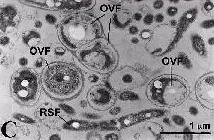 March 9:
March 9: The microfossils in Tatahouine are biological. This is the conclusion of a multi-disciplinary team from France that examined fragments of the Tatahouine meteorite and the soil where it fell, in 1931. Carefully grown cultures produced forms resembling those also found in ALH 84001, the famous meteorite from Mars. Many critics have said that microfossils smaller than about 200 nanometers in diameter are too small to be biological. This research demonstrates that the smaller forms are "at least remains of bacteria." The work follows up a preliminary report by members of the same team, in 1998. [Thanks, Larry Klaes.]
 Ph. Gilleta, J.A. Barrat, Th. Heulin, W. Achouak, M. Lesourd, F. Guyot and K. Benzerara. "Bacteria in the Tatahouine meteorite: nanometric-scale life in rocks" [link], p 161-167 v 175 Earth and Planetary Science Letters, March 2000. Ph. Gilleta, J.A. Barrat, Th. Heulin, W. Achouak, M. Lesourd, F. Guyot and K. Benzerara. "Bacteria in the Tatahouine meteorite: nanometric-scale life in rocks" [link], p 161-167 v 175 Earth and Planetary Science Letters, March 2000.
 Philip Ball, "Resurrecting life on Mars?" [text], Nature: Science update, 6 March 2000. Philip Ball, "Resurrecting life on Mars?" [text], Nature: Science update, 6 March 2000.
 Life on Mars! is a related CA webpage. Life on Mars! is a related CA webpage.
 Pieces of a meteorite... is a What'sNEW story on the earlier report by the same team.
Evidence that nanobacteria are biological also comes from a pair of biochemists from Finland who found that they "can be cultured with a doubling time of about 3 days." They suggest that cells "may fragment into numerous tiny units that can later be reassembled... to produce a fully competent replicant form." This evidence was presented at a conference in Denver, 20-22 July 1999. Pieces of a meteorite... is a What'sNEW story on the earlier report by the same team.
Evidence that nanobacteria are biological also comes from a pair of biochemists from Finland who found that they "can be cultured with a doubling time of about 3 days." They suggest that cells "may fragment into numerous tiny units that can later be reassembled... to produce a fully competent replicant form." This evidence was presented at a conference in Denver, 20-22 July 1999.
 Olavi E. Kajander and Neva Çiftçioglu. "Nanobacteria as extremophiles," in Instruments, Methods, and Missions for Astrobiology II, Richard B. Hoover, Editor, Proceedings of SPIE Vol. 3755 p. 106-112 (1999).
And a team of Russian bacteriologists proposes that "formation of nanocells is a common response of bacteria to stress." Furthermore, nanocells that had formed under microwave stress "grew, formed a cell envelope, and reversed to initial shapes and sizes." These findings were presented at a conference in San Diego, 20-22 July 1998. Olavi E. Kajander and Neva Çiftçioglu. "Nanobacteria as extremophiles," in Instruments, Methods, and Missions for Astrobiology II, Richard B. Hoover, Editor, Proceedings of SPIE Vol. 3755 p. 106-112 (1999).
And a team of Russian bacteriologists proposes that "formation of nanocells is a common response of bacteria to stress." Furthermore, nanocells that had formed under microwave stress "grew, formed a cell envelope, and reversed to initial shapes and sizes." These findings were presented at a conference in San Diego, 20-22 July 1998.
 Mikhail Vainshtein, Ekaterina Kudryashov, Natalia Suzina, Elena Ariskina and Vadim Voronokov. "Formation of bacterial nanocells" [abstract], in Instruments, Methods, and Missions for Astrobiology, Richard B. Hoover, Editor, Proceedings of SPIE Vol. 3441, p 95-104 (1998). Mikhail Vainshtein, Ekaterina Kudryashov, Natalia Suzina, Elena Ariskina and Vadim Voronokov. "Formation of bacterial nanocells" [abstract], in Instruments, Methods, and Missions for Astrobiology, Richard B. Hoover, Editor, Proceedings of SPIE Vol. 3441, p 95-104 (1998).
 March 8:
March 8: A carbonaceous asteroid was observed passing Earth. "1998 KY26" was slightly more than twice as distant as the moon when it was studied, 2-8 June 1998. It is roughly 30 meters in diameter (smaller than some of the telescopes aimed at it!), and rotating once every 10.7 minutes (a surprisingly rapid spin). "Part of a recently recognized, potentially abundant subpopulation of small near-Earth asteroids..., it is more accessible to a spacecraft rendezvous than any of the other ~25,000 known asteroids with secure orbits." Of further interest to us, its optical and radar properties indicate that its composition is similar to carbonaceous chondrites. "They contain complex organic compounds as well as 10-20% water. Some carbonaceous chondrites contain amino acids and nucleic acids." [Thanks, Andrew Yee and CC-NET.]
 Steven J. Ostro, et al. (20 authors), "Radar and Optical Observations of Asteroid 1998 KY26", p 557-559 v 285 Science, 23 July 1999. Steven J. Ostro, et al. (20 authors), "Radar and Optical Observations of Asteroid 1998 KY26", p 557-559 v 285 Science, 23 July 1999.
 "Fast-Spinning Asteroid Studied," p 8 n 87 Lunar and Planetary Information Bulletin, Fall 1999. "Fast-Spinning Asteroid Studied," p 8 n 87 Lunar and Planetary Information Bulletin, Fall 1999.
 Comets: The Delivery System is a related CA webpage. Comets: The Delivery System is a related CA webpage.
March 3: An essay opposing panspermia, "Plausibility, Significance and the Panspermia Epidemic," by Jon Richfield is reproduced on a new "Replies" page. The ensuing correspondence is also there.
 Plausibility, Significance and the Panspermia Epidemic Plausibility, Significance and the Panspermia Epidemic
 March 2:
March 2: NASA may crash Galileo to avoid contaminating Europa. NASA believes that the Galileo spacecraft that has been in space for 11 years may still contain viable germs. NASA also believes there may be life in the ocean under Europa's icy surface. Both possibilities are real enough that NASA will take action to assure that Galileo avoids Europa.
 Galileo Spacecraft May Be Crashed, Yahoo! News, 2 March 2000. Galileo Spacecraft May Be Crashed, Yahoo! News, 2 March 2000.
 Crash plan for Galileo spaceprobe, BBCNews, 3 March 2000. Crash plan for Galileo spaceprobe, BBCNews, 3 March 2000.
 What's the endgame for Galileo?, MSNBC.com, 2 March 2000. What's the endgame for Galileo?, MSNBC.com, 2 March 2000.
March 2: Stanislav Zhmur says that the fossils in Murchison are not earthly contaminants. In English, he writes, "Now referring to contamination. I'll give only the facts, which minimize this problem referring to the remnants of microorganisms that have been examined. This refers to all carbonaceous meteorites, Murchison included.
 "First, only lithified remnants of microorganisms closely connected with the mineral matrix of meteorites were taken for analysis. In the processes of lithification there participated petrogenic as well as metal components. It is hardly possible to imagine that these processes were excluded from the conditions under which the meteorites had been formed. "First, only lithified remnants of microorganisms closely connected with the mineral matrix of meteorites were taken for analysis. In the processes of lithification there participated petrogenic as well as metal components. It is hardly possible to imagine that these processes were excluded from the conditions under which the meteorites had been formed.
 "Second, the variety of lithified microorganisms is very great. We found not only remnants of microorganisms, but also traces of their metabolic activity (mineralized glicocalix). In fact practically all microorganisms identified have analogues in modern and ancient cyanobacterial mats. This point is of special importance given the well known fact that cyanobacteria have gone unchanged through practically the whole geological history of the Earth. As well as the fact that cyanobacteria participate in forming highly carbonaceous rocks on Earth (oil and black shales). "Second, the variety of lithified microorganisms is very great. We found not only remnants of microorganisms, but also traces of their metabolic activity (mineralized glicocalix). In fact practically all microorganisms identified have analogues in modern and ancient cyanobacterial mats. This point is of special importance given the well known fact that cyanobacteria have gone unchanged through practically the whole geological history of the Earth. As well as the fact that cyanobacteria participate in forming highly carbonaceous rocks on Earth (oil and black shales).
 "And lastly, carbonaceous meteorites contain a number of carbonaceous materials inherent to earthly sapropelic organic matter." "And lastly, carbonaceous meteorites contain a number of carbonaceous materials inherent to earthly sapropelic organic matter."
 Another respectable source within NASA acknowledges that meteorites become contaminated easily. But this does not mean that all fossils in meteorites are contaminants. Freshly fractured samples of Murchison are usually found not to be contaminated, he says. And the carbonaceous material to which Zhmur refers cannot form within the time available after Murchison landed, in 1969. Another respectable source within NASA acknowledges that meteorites become contaminated easily. But this does not mean that all fossils in meteorites are contaminants. Freshly fractured samples of Murchison are usually found not to be contaminated, he says. And the carbonaceous material to which Zhmur refers cannot form within the time available after Murchison landed, in 1969.
 Furthermore we observe that microfossils are found only in carbonaceous meteorites, which constitute only about 4% of all meteorites that reach Earth. If the microfossils are earthly contaminants, why aren't they found occasionally in non-carbonaceous meteorites? Furthermore we observe that microfossils are found only in carbonaceous meteorites, which constitute only about 4% of all meteorites that reach Earth. If the microfossils are earthly contaminants, why aren't they found occasionally in non-carbonaceous meteorites?
 It is proper for science to be sceptical of new theories. But carbonaceous meteorites may well contain fossils of extraterrestrial bacteria. Please stay tuned! It is proper for science to be sceptical of new theories. But carbonaceous meteorites may well contain fossils of extraterrestrial bacteria. Please stay tuned!
 Pictures of fossils in two carbonaceous meteorites is the What'sNEW item announcing the photos (27 January 2000) with which this discussion originates. Pictures of fossils in two carbonaceous meteorites is the What'sNEW item announcing the photos (27 January 2000) with which this discussion originates.
 Fossilized Bacteria in Murchison and Efremovka is the CA webpage containing Zhmur and Gerasimenko's photos. Fossilized Bacteria in Murchison and Efremovka is the CA webpage containing Zhmur and Gerasimenko's photos.

|











